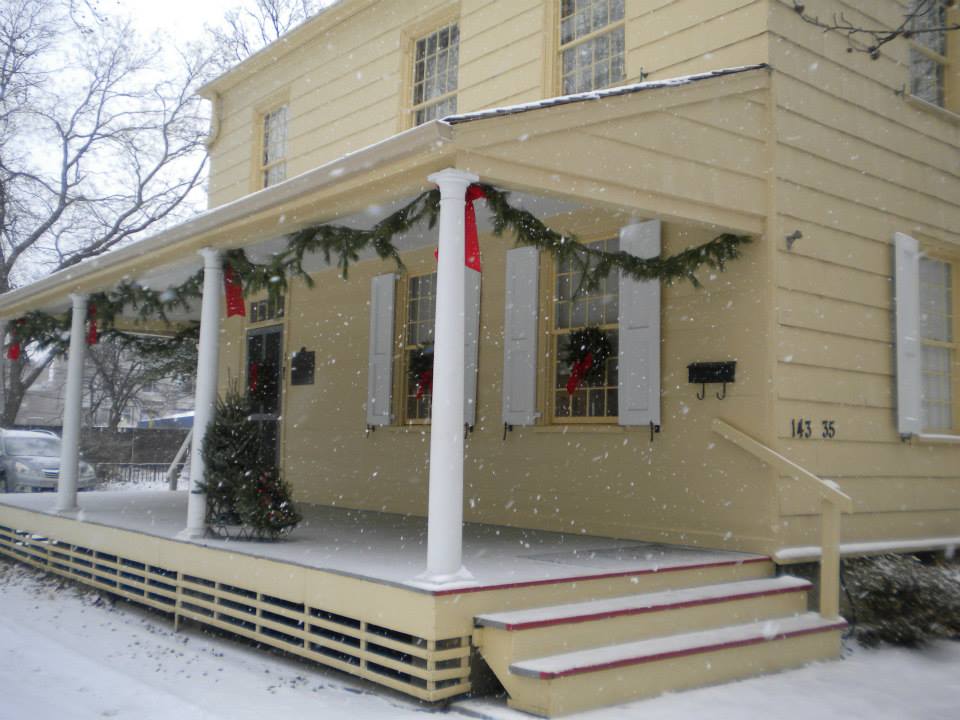Wine isn’t the only thing that gets better with age! Seven Queens landmarks will open their doors to the public during the 30th Annual Holiday Historic House Tour on Sunday, Dec. 10, from 1 pm to 5 pm. The tour will feature time-honored, family-friendly activities, performances, and refreshments. Tickets are $15 in advance, but $20 at the door. Children under age 12 can attend for $5.
Sponsored by The Kindler Foundation, Con Edison, the Sheraton LaGuardia East Hotel, the Greater Flushing Chamber of Commerce, and the Queens Historical Society, visitors will walk at their own pace and/or take a dedicated shuttle to the different venues between Flushing and Corona. Most of the participating sites — Louis Armstrong House Museum; Bowne House; Flushing Town Hall; Quaker Meeting House; Kingsland Homestead; Lewis H. Latimer House Museum; and Voelker Orth House — will be decorated as they were during their first holiday seasons.
And as this year, 2017, marks New York’s centennial of women’s suffrage, which led to women getting the right to vote, the historic houses will celebrate their female inhabitants along with the holiday season. Descriptions of the venues and their tour plans follow.
Lucille Armstrong and her legendary jazz musician husband lived in what is now the Louis Armstrong House Museum (34-56 107th St., Corona) from 1943 until her death in 1983. The inside of this landmarked home remains unchanged; a timeless snap shot of their life in the neighborhood that inspired Satchmo’s classic song “What a Wonderful World.”
Lucille was the mastermind behind the marble bathroom with 24-carat, gold-plated fixtures and mirrors over the walls; the living room with dozens of objects they collected during their travels; and the den, a “man cave” demonstrating a restless artist eager to archive and revisit his life. To honor Lucille and her unique decorative touch, the residence will be brightly decorated for the holidays. Her character will be revealed through stories that highlight her active relationship with the community. The tour will feature rare audio clips from Satchmo’s personal recordings, and visitors will hear the trumpeter’s magical voice reading ’Twas the Night Before Christmas, A Visit from St. Nicholas in 1971, and other seasonal recordings.
−Continues−
English-born religious freedom advocate John Bowne built the Bowne House (37-01 Bowne St., Flushing) in 1661. It’s the borough’s oldest domicile and has city, state, and federal landmark status. Nine generations of the Bowne and Parsons families lived in the residence until 1945, when it became a museum. The structure, which has a unique blend of Dutch and English construction techniques, has just completed a stabilization and exterior restoration.
On Dec. 10, the house will present an exhibition on the history of Christmas, highlighting women’s roles in the celebration. It will also display eyeglasses, ceramics, door handles, toothbrushes, and other artifacts that were uncovered during a 2013 archeological investigation of the kitchen area. (The quest also unearthed one of the largest cisterns ever found in the NYC Metropolitan Area.) Bowne personnel will also unveil the Legends and Lore of the Bowne House exhibition on this day.
Built in 1862, Flushing Town Hall (137-35 Northern Blvd., Flushing) was the cultural and political focal point of the village in the late 19th century. The Romanesque Revival building hosted swearing-in ceremonies for Union soldiers before the Civil War and later served as an opera house, a courthouse, a jail, and a bank branch. Recently, it has evolved into a dynamic cultural venue presenting Global Arts for a Global Community. Visitors will have the opportunity to shop at the annual Holiday Market for everything from handmade clothing and jewelry to paintings, posters, figurines, and ceramics.
To celebrate the centennial of women’s suffrage in New York, Flushing Town Hall will highlight jazz legend (and Queens resident) Ella Fitzgerald by playing her music throughout the market and displaying panels with information about her life and career.
When the Quaker Meeting House (137-16 Northern Blvd., Flushing) was constructed in 1694, it was the first house of worship in a town that was then called “Vlissengen.” Now it’s New York’s oldest structure in continuous use for religious purposes. The tour will end there with live performances, folk singing, and hot apple cider. Visitors will be able to walk around the grounds and view the historic cemetery.
Quaker women in Flushing were at the forefront of the movements to abolish slavery, expand educational opportunity, and obtain women’s suffrage. For the tour, the house will honor the Flushing Female Association, which established the area’s first free school in 1814. For more than 100 years, the school flourished, primarily serving the African-American community.
Charles Doughty, a wealthy Quaker’s son, built a Victorian domicile in 1785. The estate became Kingsland Homestead (143-35 37th Ave., Flushing) after his son-in-law, a British sea captain named “Joseph King,” bought it in 1801. Five generations of the King/Murray family lived there until the 1930s. In 1968, the dwelling was moved from its original Flushing site to its current location, where it serves as the Queens Historical Society’s headquarters.
−Continues−
For the tour, the homestead will emphasize Annie Cornelia Mitchell Murray, who lived there in the mid-to-late 1800s. She spoke and read fluently in several languages. (Goethe was her favorite writer, and she read him in German.) Annie trained as a nurse with Elizabeth Blackwell at Bellevue Hospital for service in the United States Sanitary Commission, the relief agency for sick and wounded Union soldiers during the Civil War. The Queens Historical Society’s archives contain the Mitchell Family Papers, which provide an intimate picture of Annie’s family life which varies drastically from the Victorian stereotype. Annie was raised as an equal to her brother; her parents treated her as an intelligent human.
Lewis Howard Latimer lived in a 19th century Victorian house (34-41 137th St., Flushing) from 1902 until his death in 1928. The African-American son of fugitive slaves was vital in developing the telephone and the incandescent light bulb, and was also a poet, painter, and musician. The guided tour will introduce his story and time, along with his original lamps and art works, the Tinker Lab, and Interactive Poetry Installation. Traditional holiday refreshments will be offered throughout the afternoon.
During the tour, a short film with extensive interviews of his granddaughter, Dr. Winifred Latimer Norman, who fought to save the historical house and raise awareness of her grandfather’s contributions to science, will be screened. Additionally, the Latimer House will host a special workshop with NOCD-NY (Naturally Occurring Cultural Districts New York) to engage visitors in discussing their neighborhoods’ cultural landscape.
Voelker Orth House (149-19 38th Ave., Flushing) dates to 1891 and provided shelter to three generations of a family with German roots. The Voelker granddaughter, Elisabeth “Betty” Orth (1926-1995) bequeathed her estate to establish the museum, preserving a view of Flushing’s past. The garden contains many popular plants and berry bushes of the late 19th century. They are maintained with time-honored gardening techniques (no pesticides) for birds, butterflies and honey bees to feast upon and pollinate.
For the tour, the Victorian abode will be dressed in a traditional German-American style much the way the Voelker and Orth women would have transformed their home to welcome friends and family during the holidays. Guests will be invited to add some gum drops to the gingerbread houses and peruse a gift-and-plant sale. They can also join a sing-along with pianist and vocal coach Kenneth Gartman and enjoy pfeffernüsse (tiny spice cookies), other sweets, and hot mulled cider. An exhibition of paintings by German émigré Elizabeth Korn (1900-1979) is on view.






